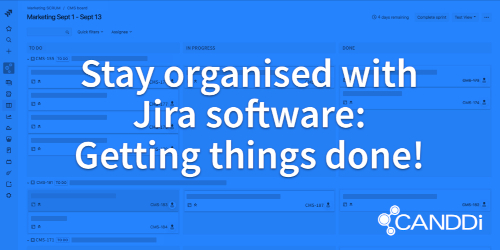Blog and News > marketing > How to lead a focused, productive marketing team (part 3)
How to lead a focused, productive marketing team (part 3)
In this series of articles, we’re sharing insights into how we keep the CANDDi marketing team organized. Make sure you read the other two parts first.
Part 1: Scrums and sprints
Part 2: Super-effective meetings
In this final part, we look at the software we use to stay on the same page, and share insights into getting as much done as possible.

Staying organised with software
With all the tasks and actions set for the next sprint, we have to get organised with a way of ensuring everyone knows how much progress has been made across the whole team.
We’d recommend you use software for this task. The problem is, many scrum management apps are principally designed for software developers and look more like development tools than something a marketer would feel comfortable using. That’s why we use Atlassian’s Jira software. It has a nice, clean layout that allows everyone to see how the sprint is progressing.
Within Jira, we have each task laid out, complete with a description written in a format that makes it easy for everyone to understand not just what we’re doing, but why, and who for.
Here’s an example:
Task title: Refactor our Blog template to include “Twitter summary with large image code”
As a CANDDi Marketing person, I want social shares of our blog posts to look as good as possible.
Acceptance Criteria
- Get Twitter code from strategy doc
- Developer ticket raised to change template
- Refactor images on last 10 blog posts if required
As you can see, the description is written from the perspective of the person (or people) the task is designed to benefit, even though the entire task may not be carried out by that person.
Every task is broken down into actions, depicted as individual cards. Each card is assigned to a person on the team. So, to stick with the example above, perhaps it will be Maria’s job to get the twitter code from the strategy doc, but Bob’s task to raise the developer ticket.
Each card starts in the left-hand column, which is the ‘to-do’ list. When Maria is ready to start getting the Twitter code from the strategy doc, she can move the associated card to the right, into ‘In progress.’ Then once she’s finished, she can move her card right again, into the ‘Done’ column.
Getting things done
It’s really satisfying to see the cards filling up the ‘Done’ column in Jira as the sprint progresses. Having this visual overview also helps the scrum master identify where any bottlenecks are, so they can be resolved. Use your daily ‘standup’ meetings (see part 1) to keep everything on track.
It’s important that once the workload for a sprint is agreed, everyone sticks to it. Don’t change tasks, or add more, and make sure you only include a manageable amount of work in each sprint.
The idea is to achieve all the goals you set, not leave a lot of them half-done because you underestimated how long each would take. The only time a scrum master should change the content of a sprint mid-way is if the company’s overall strategy takes a sudden and unexpected change of course, or something else huge happens that you need to drop everything to deal with Don’t forget while we’d love you to take inspiration from this series, you should adapt the process over time to suit your company’s individual characteristics. Just remember the central mission here is to keep your team productive, and achieve your goals in a positive, timely manner. If you’re doing that, it’s working!
And finally, here’s a tip we find particularly useful: complete the difficult actions early on in the sprint. The relief of having got the ‘tough bits’ done makes the rest of the sprint much more enjoyable than if you have a lot of hard work looming throughout the first week.